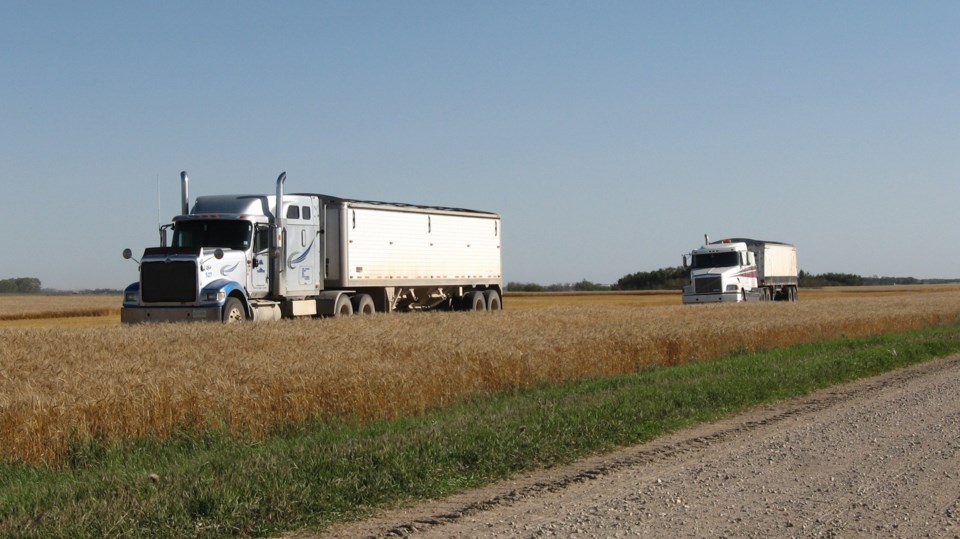Farmers made significant harvest progress again this week.
Sixty-two per cent of the crop has been combined, up from 43 per cent last week and well ahead of the five-year (2015-2019) average of 48 per cent.
An additional 27 per cent of the crop is swathed or ready to straight-cut. Warm and dry weather is needed to continue drying down crops.
East-Central Saskatchewan:
·Crop District 5 – Melville, Yorkton, Cupar, Kamsack, Foam Lake, Preeceville and Kelvington areas
·Crop District 6A – Lumsden, Craik, Watrous and Clavet areas
Dry conditions this week allowed for good harvest progress in the region. Fifty-one per cent of the crop has been combined, up from 29 per cent last week and ahead of the five-year average (2015-2019) of 37 per cent. An additional 37 per cent of the crop is swathed or ready to straight-cut. Recent cool, damp temperatures have slowed the dry down of none mature crops and some of the crop is coming off tough and needing to be placed into aerations bins or dried.
Minimal rainfall was received in much of the east-central region. The highest amount of rain received this past week was six mm in the Lipton, Kelliher, Raymore, Semans and Kenaston areas. The Esterhazy area received 4 mm, the Goodeve and Earl Grey areas three mm and the Craik area two mm. None or trace amounts of rain were reported in Crop District 5B. The Langenburg area has received the most precipitation in the region since April 1 with 310 mm.
Warm, dry conditions are desired to aid with harvest progress, but many are hoping for high amounts of precipitation after harvest to replenish topsoil and subsoil moisture. Cropland topsoil moisture is rated as 32 per cent adequate, 33 per cent short and 35 per cent very short. Hay and pasture land topsoil moisture is rated as 34 per cent adequate, 50 per cent short and 16 per cent very short.
Durum grades in the region are currently being estimated as 35 per cent 1 CW, 37 per cent 2 CW, 25 per cent 3 CW and three per cent 4 and 5 CW. Pea grades are estimated as 54 per cent 1 CAN, 45 per cent 2 CAN and one per cent 3 CAN. Lentil grades are estimated to be 52 per cent 1 CAN, 47 per cent 2 CAN and one per cent 3 CAN.
The majority of crop damage was due to frost, wind and lack of moisture. Wind has caused swaths to blow around and for crops to shell out. There was also reported damage caused by waterfowl.
Farmers are busy combining, swathing, baling and hauling bales.
Provincially
Harvest is most advanced in the southwest region, where 90 per cent of the crop is in the bin. The southeast has 77 per cent combined, the west-central 61 per cent, the east-central 51 per cent, the northeast 33 per cent and the northwest 18 per cent.
Ninety-seven per cent of lentils, 94 per cent of field peas, 87 per cent of mustard, 72 per cent of barley, 86 per cent of durum, 69 per cent of chickpeas, 55 per cent of spring wheat, 42 per cent of canola and 28 per cent of flax has now been combined. An additional 47 per cent of canola is swathed or ready to straight-cut.
Durum grades are estimated as 55 per cent 1 CW, 33 per cent 2 CW, nine per cent 3 CW and three per cent 4 CW and 5 CW. Pea grades are estimated as 38 per cent 1 CAN, 56 per cent 2 CAN and six per cent 3 CAN. Lentil grades are estimated to be 35 per cent 1 CAN, 58 per cent 2 CAN, six per cent 3 CAN and one per cent sample grade.
Most of the province received very little rainfall this week. The Nipawin area received the highest amount of rain with 25 mm. Topsoil moisture conditions in the province continue to deteriorate due to strong winds and minimal rainfall. Cropland topsoil moisture is rated as 30 per cent adequate, 41 per cent short and 29 per cent very short. Hay and pasture land topsoil moisture is rated as 26 per cent adequate, 33 per cent short and 41 per cent very short.
The majority of crop damage this week was due to frost, wind and dry conditions. Damage from frost varied depending on the temperature and stage of the crop, with later seeded and less mature crops impacted the most. Wind continued to blow swaths and shell out crops. There were also reports of damage caused by wildlife, waterfowl and ergot in durum crops.
Farmers are busy combining, swathing, hauling bales and moving cattle.
With harvest underway in Saskatchewan, we want to remind producers to exercise caution and remain safe.
A complete, printable version of the Crop Report is available online at https://www.saskatchewan.ca/crop-report.
Follow the 2020 Crop Report on Twitter at @SKAgriculture.



